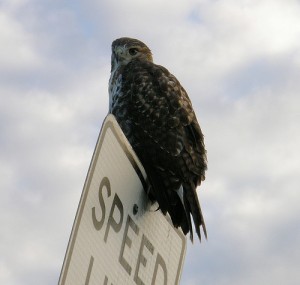Originally posted on Connected Principals

When I taught sixth grade science, our students were immersed in learning about wildlife characteristics, environments, and patterns in nature in relation to the Hawk Mountain Sanctuary and our surrounding region. For weeks we explored and discussed the habitats and migratory cycles of raptors, plant life, conservation, as well as the formation of the “river of rocks” and other natural phenomenon that delighted children and helped spark in them a real desire to learn more about the environment. Our culminating day-long adventure to the sanctuary (just a short drive from campus… lucky us!) provided students with an appreciation for, and deeper understanding of, the beautiful and fascinating world of nature that surrounds them.This is a unit that was important to us personally, as residents of the Hawk Mountain area. Yes, there were PA science “standards” that related to our content, but we delved deeper. Had we only covered the required content standards at surface value, it would not have yielded as many benefits for students.This week’s #edchat was about how to close the gap between connected and non-connected groups of educators. I appreciate the many comments that pushed my thinking, like from Jon Becker who inquired whether I believed that if teachers/educators were not connected they weren’t learning or growing professionally. My response?
 In one way, this planning for and inclusion of the Hawk Mountain experience in our curriculum required a certain level of connectedness among staff and the local area. At some point, teachers recognized the importance of including this environment in students’ learning experiences, and they made it a point to plan for that. It involved connecting oneself with the sanctuary in order to plan for the field trip, access resources, etc., as well as connecting with one another in order to plan for a meaningful unit for students, as there were many cross-curricular connections developed.
In one way, this planning for and inclusion of the Hawk Mountain experience in our curriculum required a certain level of connectedness among staff and the local area. At some point, teachers recognized the importance of including this environment in students’ learning experiences, and they made it a point to plan for that. It involved connecting oneself with the sanctuary in order to plan for the field trip, access resources, etc., as well as connecting with one another in order to plan for a meaningful unit for students, as there were many cross-curricular connections developed.
Later in the #edchat conversation questions were raised about how we determine if teachers are growing professionally: what measures we use, how we use data, why we use it, who should be evaluating teachers and how, should we be considering other measures, why are we measuring everything, can we measure what’s important? And so on, and so forth.
Frankly, if you are not a connected educator at this point, you may not have an awareness that we are at a critical juncture in education. These driving questions must be answered. If you are not a connected educator, how can you support your own professional growth and the success of your children if you are not constantly questioning, re-evaluating, and striving for improvement?
It’s clear we’re not the only ones raising the questions above. We know our politicians and government systems (read: non-practicing educators) are working to design and implement common standards (the Common Core is coming for you, too, science). They are determining for schools across the country what’s important to teach. How do we feel about that? Where are the very important elements of local control and student ownership in all of this? Mary Ann reflects on Common Core’s definition of what types of text students need to be read in order to build comprehension. Will wonders, what do we absolutely need to teach?
And to improve student learning outcomes we need to ramp up teacher evaluation systems, correct? The “latest and greatest” systems rely heavily on student achievement data to determine teacher effectiveness. Principals and central office administrators are trying to wrap their heads around the new state-issued teacher evaluation systems that are draining their time, energy, and according to at least one principal, their passions. Increased principal presence in the classroom? Yay. Getting lost in 3-4 hours of cumbersome rubrics and paperwork per observation? Nay. Superintendent Kimberly Moritz ponders, How are we going to do this work? In Pennsylvania, a new teacher evaluation system is set to be implemented, where 50% of teacher evaluations are based on students’ standardized test scores and growth data. Should we consider perhaps more comprehensive standards of learning for our teachers in order to promote true professional growth?
Administrators, get connected. First, with yourself and your beliefs. What do you know about your communities and students, and the world in which we exist? What is important for children to know and be able to do? If you don’t know – find out. FROM KIDS, the community, and others around the world. Next, connect with your own school and administrative councils. Consider what you’re asking your teachers to teach; why you’re doing so; how you’re evaluating the effectiveness of the learning environments in your schools; when and how often you’re going to push the status quo and start demanding changes in your school’s curriculum, assessment, teacher evaluation systems, and instructional methods in order to provide more authentic learning for your children. Get connected. Make your voices heard among bodies of decision-making leaders, starting with your own administrative council and moving beyond into your state and national organizations.
There are schools and systems out there that are getting it right: they’re designing innovative learning experiences for students, and those students have immense ownership over their learning; they’re being guided by a curriculum in which they have personally invested time, effort, and input because it contains great value for the learners and places emphasis on skills such as creativity, critical thinking and global engagement; they understand how to most effectively evaluate teachers and their impact on student learning. Connect with these schools. Learn from them.
We can’t lose sight of what we know is important. We can’t lose the chance to engage our children with the beauty of the Hawk Mountains of the world. Being a connected educator is so much more than Tweeting some resources and reflecting in a blog post. Get connected and make a difference.

Lyn, I appreciate everything you said here, but what hooked me was our Hawk Mountain connection. My family had a membership to Hawk Mountain, and I spent so many weekends on the mountain just sitting at one of the overlooks or taking part in many of their programs for kids. I’m sure that all of the time I spent there and the learning I did there is what developed my strong connection with nature. Did I learn about science in school? Sure. But I can’t tell you what I did in science at school. But I can still tell you about 3 or 4 programs I attended at Hawk Mountain as an elementary and junior high student. That’s for bringing up these wonderful memories! 🙂
That is amazing! It’s such a beautiful place. My black Lab and I spent many a day hiking the trails in the nearby area as well. I remember attending the trip as a sixth grader, and it meant so much to me to be able to take groups of students there as well. Thanks for sharing, Becky!